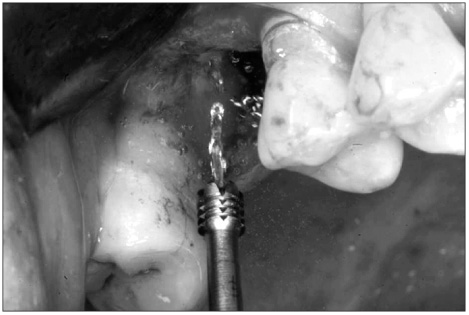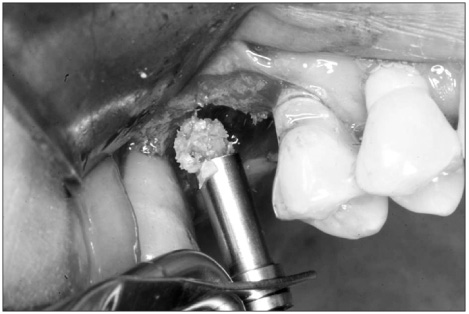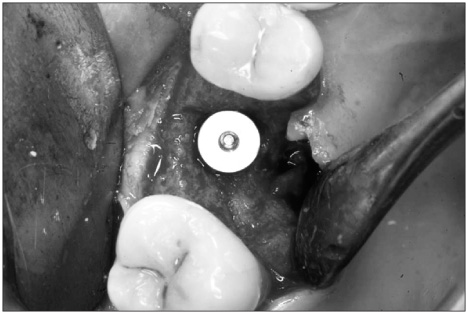J Korean Assoc Oral Maxillofac Surg.
2012 Apr;38(2):85-89. 10.5125/jkaoms.2012.38.2.85.
Multicenter clinical study on the hydrodynamic piezoelectric internal sinus elevation (HPISE) technique
- Affiliations
-
- 1Department of Dentistry and Oral and Maxillofacial Surgery, Daegu Catholic University Medical Center, Daegu, Korea. dssohn@cu.ac.kr
- 2Department of Oral and Maxillofacial Surgery, Chung-Ang University College of Medicine, Seoul, Korea.
- KMID: 2189696
- DOI: http://doi.org/10.5125/jkaoms.2012.38.2.85
Abstract
OBJECTIVES
This study was to evaluate the effect of vertical bone gain and success rate and analyze the failure cases using the hydrodynamic piezoelectric internal sinus elevation (HPISE) technique.
MATERIALS AND METHODS
Patients who had been operated in the three centers including Daegu Catholic University Medical Center were selected for this study. The mucoperiosteal flap was elevated, and the sinus floor was then broken by specially designed piezoelectric insert, with hydraulic pressure applied to the sinus membrane for even elevation. Afterward, implants were placed. Panoramic radiogram or computed tomogram was taken before and after surgery and at the second operation and prosthesis placement. Later, changes in vertical height were measured and compared. The survival rate was based on the criteria of Buser et al. and Cochran et al.
RESULTS
In this study, 8 implants failed out of a total of 169 implants, resulting a success rate of 95.3%. These failure cases were due to insufficient initial stability or sinus membrane perforation. The mean of radiographic vertical height change at prosthesis placement was 5.7 mm (0.5-10.5 mm).
CONCLUSION
In this study, HPISE technique was found to be a predictable treatment for atrophic maxilla and an alternative technique to the lateral approach.
Keyword
MeSH Terms
Figure
Reference
-
1. Atwood DA. Bone loss of edentulous alveolar ridges. J Periodontol. 1979. 50:11–21.
Article2. Misch CE. Maxillary sinus augmentation for endosteal implants: organized alternative treatment plans. Int J Oral Implantol. 1987. 4:49–58.3. Smiler DG, Johnson PW, Lozada JL, Misch C, Rosenlicht JL, Tatum OH Jr, et al. Sinus lift grafts and endosseous implants. Treatment of the atrophic posterior maxilla. Dent Clin North Am. 1992. 36:151–186.4. Boyne PJ, James RA. Grafting of the maxillary sinus floor with autogenous marrow and bone. J Oral Surg. 1980. 38:613–616.5. Adell R, Lekholm U, Grondahl K, Branemark PI, Lindstrom J, Jacobsson M. Reconstruction of severely resorbed edentulous maxillae using osseointegrated fixtures in immediate autogenous bone grafts. Int J Oral Maxillofac Implants. 1990. 5:233–246.6. Raghoebar GM, Vissink A, Reintsema H, Batenburg RH. Bone grafting of the floor of the maxillary sinus for the placement of endosseous implants. Br J Oral Maxillofac Surg. 1997. 35:119–125.
Article7. Aghaloo TL, Moy PK. Which hard tissue augmentation techniques are the most successful in furnishing bony support for implant placement? Int J Oral Maxillofac Implants. 2007. 22:Suppl. 49–70.8. Summers RB. A new concept in maxillary implant surgery: the osteotome technique. Compendium. 1994. 15:152154–156. 158 passimquiz 162.9. Summers RB. The osteotome technique: Part 2--The ridge expansion osteotomy (REO) procedure. Compendium. 1994. 15:422. 424. 426. passim. quiz 436.10. Summers RB. The osteotome technique: Part 3--Less invasive methods of elevating the sinus floor. Compendium. 1994. 15:698. 700. 702. 704 passim. quiz 710.11. Di Girolamo M, Napolitano B, Arullani CA, Bruno E, Di Girolamo S. Paroxysmal positional vertigo as a complication of osteotome sinus floor elevation. Eur Arch Otorhinolaryngol. 2005. 262:631–633.
Article12. Peñarrocha M, Garcia A. Benign paroxysmal positional vertigo as a complication of interventions with osteotome and mallet. J Oral Maxillofac Surg. 2006. 64:1324.
Article13. Cochran DL, Buser D, ten Bruggenkate CM, Weingart D, Taylor TM, Bernard JP, et al. The use of reduced healing times on ITI implants with a sandblasted and acid-etched (SLA) surface: early results from clinical trials on ITI SLA implants. Clin Oral Implants Res. 2002. 13:144–153.
Article14. Buser D, Mericske-Stern R, Bernard JP, Behneke A, Behneke N, Hirt HP, et al. Long-term evaluation of non-submerged ITI implants. Part 1: 8-year life table analysis of a prospective multi-center study with 2359 implants. Clin Oral Implants Res. 1997. 8:161–172.
Article15. Coatoam GW, Krieger JT. A four-year study examining the results of indirect sinus augmentation procedures. J Oral Implantol. 1997. 23:117–127.16. Wallace SS, Froum SJ. Effect of maxillary sinus augmentation on the survival of endosseous dental implants. A systematic review. Ann Periodontol. 2003. 8:328–343.
Article17. Del Fabbro M, Testori T, Francetti L, Weinstein R. Systematic review of survival rates for implants placed in the grafted maxillary sinus. Int J Periodontics Restorative Dent. 2004. 24:565–577.
Article18. Toffler M, Toscano N, Holtzclaw D. Osteotome-mediated sinus floor elevation using only platelet-rich fibrin: an early report on 110 patients. Implant Dent. 2010. 19:447–456.
Article19. Sohn DS, Moon JW, Moon KN, Cho SC, Kang PS. New bone formation in the maxillary sinus using only absorbable gelatin sponge. J Oral Maxillofac Surg. 2010. 68:1327–1333.
Article20. Shin HI, Sohn DS. A method of sealing perforated sinus membrane and histologic finding of bone substitutes: a case report. Implant Dent. 2005. 14:328–333.
Article21. Le Gall MG. Localized sinus elevation and osteocompression with single-stage tapered dental implants: technical note. Int J Oral Maxillofac Implants. 2004. 19:431–437.22. Lundgren S, Andersson S, Gualini F, Sennerby L. Bone reformation with sinus membrane elevation: a new surgical technique for maxillary sinus floor augmentation. Clin Implant Dent Relat Res. 2004. 6:165–173.
Article23. Palma VC, Magro-Filho O, de Oliveria JA, Lundgren S, Salata LA, Sennerby L. Bone reformation and implant integration following maxillary sinus membrane elevation: an experimental study in primates. Clin Implant Dent Relat Res. 2006. 8:11–24.
Article24. Sohn DS, Lee JS, Ahn MR, Shin HI. New bone formation in the maxillary sinus without bone grafts. Implant Dent. 2008. 17:321–331.
Article
- Full Text Links
- Actions
-
Cited
- CITED
-
- Close
- Share
- Similar articles
-
- Comparison of implant survival rate by sinus lifting technique in implantation with sinus lift
- A lateral approach to the maxillary sinus for simultaneous extraction of an ankylosed maxillary molar and sinus graft: a case report
- THE COMPARATIVE EVALUATION USING HATCH REAMER TECHNIQUE AND OSTEOTOME TECHNIQUE IN SINUS FLOOR ELEVATION
- Clinical evaluation of Branemark Ti-Unite implant and ITI SLA implant in the post maxillary area with sinus elevation technique
- A Retrospective Evaluation of Implant Installation with Maxillary Sinus Augmentation by Lateral Window Technique





